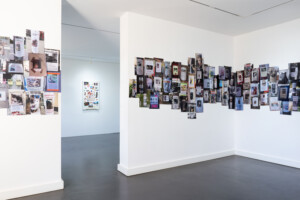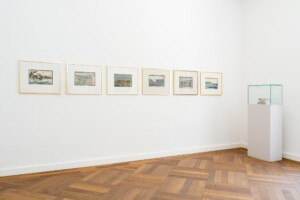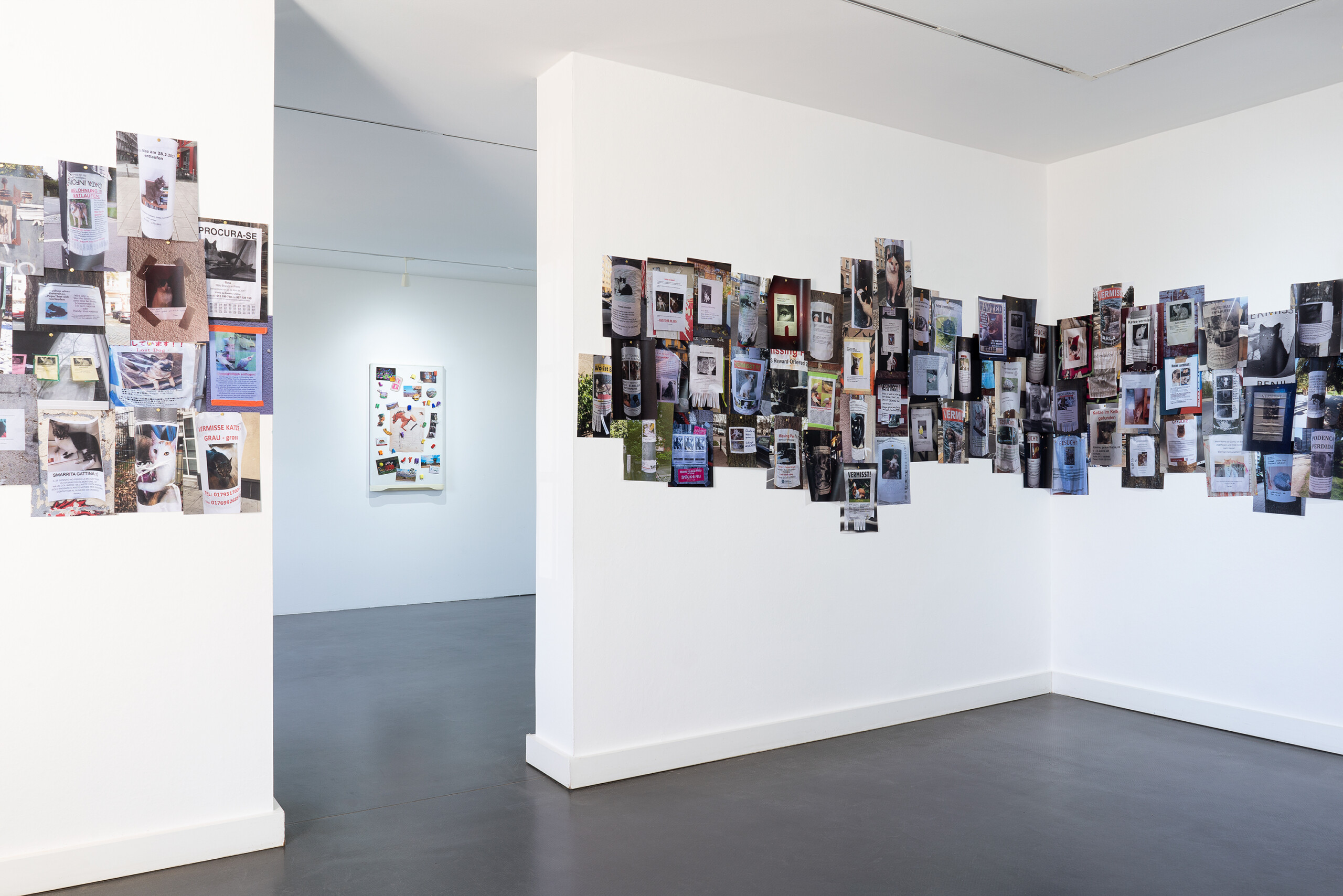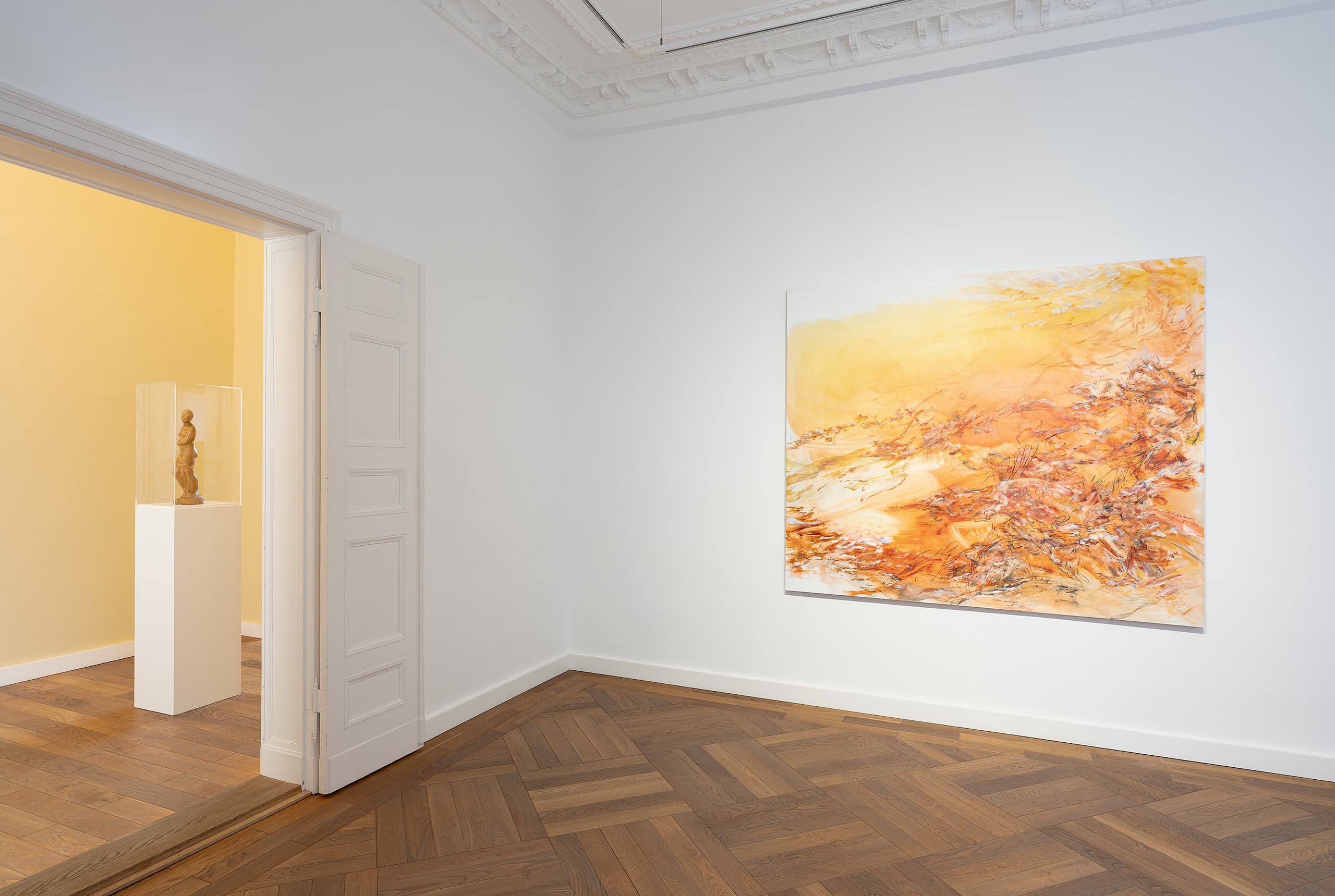Sammeln
What do you collect? As a child, it might have been sticks, stickers, or even seashells. What is it today? Stamps, refrigerator magnets, or the faded drawings of grown-up children? Almost everyone collects something, even if it’s just unopened bills on the shelf.
From June 19 to August 28, 2022, Villa Schöningen presents the exhibition “Sammeln” (collecting), showcasing individual works by contemporary artists as well as selections from various collections. These collections include missing pet posters, a collection of Spitzweg paintings, the extensive Sound Collection Guy Schraenen, a loan from the Center for Artists’ Publications, Weserburg Museum for Modern Art (Bremen), or a collection of Japanese woodcuts from the Edo period featuring works by Utagawa Hiroshige and Hiroshige II.
Collecting is always something personal, identity-affirming: This is also the theme of Lea Dreager’s work “Ökonomische Päpste und Päpstinnen” (Economic Popes and Popesses). She has now created more than 6,000 postage stamp-sized portrait drawings that she uses to explore her upbringing with Catholicism. On the other hand, Harm van den Dorpel’s “Indiscreet Units” deals with dissolving identities: He displays 266 national flags, whose shades are constantly changing – a continuous algorithm generates new nuances from the original flag color codes.
The utopian desire for completeness, the ongoing search for the missing puzzle piece – keeping things is something delicate. This becomes evident for those who have had to clear out the home of a deceased family member. They ask themselves: What should go and what should stay to serve as a memory?
In many households, the refrigerator door, beyond its intended purpose, becomes a place to collect memories. This is where Billie Clarken’s work “Trap Doors” comes into play. The artist prints found doors with photos of refrigerator doors and occasionally adds real objects. Through optical illusions, she blurs the line between reality and fiction.
But how to deal with what’s been collected? This is currently one of the biggest challenges for museums and art institutions. Most of them display only a fraction of the works they have stored. This allows for new scholarly insights, but it also requires significant resources to manage and archive all the objects that aren’t visible. And which works that entered the collection unlawfully should be returned to their original owners, and which should stay, also to serve as a memory?
The current exhibition “Sammeln” can itself be seen as a collection and will continue to evolve beyond the opening.
 Anna Sullivan, Lost Love, Privatsammlung von Vermisstenanzeigen von Haustieren, Farbdruck, Verschiedene Größen
© Villa Schöningen, Courtesy Anna Sullivan
Billie Clarken, Trap Door #6 (Signs of Interior Life), 2021, Gefundene Objekte, UV-bedruckte Kühlschranktür, Velourstoff, 95.5 x 59 x 6 cm
© Villa Schöningen, Courtesy Billie Clarken
Foto: Sascha Herrmann
Anna Sullivan, Lost Love, Privatsammlung von Vermisstenanzeigen von Haustieren, Farbdruck, Verschiedene Größen
© Villa Schöningen, Courtesy Anna Sullivan
Billie Clarken, Trap Door #6 (Signs of Interior Life), 2021, Gefundene Objekte, UV-bedruckte Kühlschranktür, Velourstoff, 95.5 x 59 x 6 cm
© Villa Schöningen, Courtesy Billie Clarken
Foto: Sascha Herrmann
 Roman Moriceau, Flowers (6), 2018, Acai, schwarze Goji Beere, Rote Beete, Kirsche, Chlorophyll, gefrorene Drachenfrucht, Phycocyanin, Goji Beere, Kurkuma, Ingwer, Matcha, 145 x 105
© Villa Schöningen, Courtesy Roman Moriceau und Galerie Derouillon,Paris
The Infamous Collection, THE PAST IS NOW USEFUL, 1983-2005, 666 Videokassetten, 18 m
© Villa Schöningen, Courtesy The Infamous Collection
Herbarium, 67 Pflanzen gepresst, Doris van den Hövel, 2011, Verschiedene Größen
© Villa Schöningen, Courtesy Doris van den Hövel
Foto: Sascha Herrmann
Roman Moriceau, Flowers (6), 2018, Acai, schwarze Goji Beere, Rote Beete, Kirsche, Chlorophyll, gefrorene Drachenfrucht, Phycocyanin, Goji Beere, Kurkuma, Ingwer, Matcha, 145 x 105
© Villa Schöningen, Courtesy Roman Moriceau und Galerie Derouillon,Paris
The Infamous Collection, THE PAST IS NOW USEFUL, 1983-2005, 666 Videokassetten, 18 m
© Villa Schöningen, Courtesy The Infamous Collection
Herbarium, 67 Pflanzen gepresst, Doris van den Hövel, 2011, Verschiedene Größen
© Villa Schöningen, Courtesy Doris van den Hövel
Foto: Sascha Herrmann
 Marc Einsiedel & Felix Jung, Knochenporzellan, 2022, Archivierte Knochen aus der Themse, London, 3 x 12 m, Produziert, ausgestellt und fotografiert von Slate Projects
© Villa Schöningen, Courtesy Einsiedel & Jung und Slate Projects
Foto: Sascha Herrmann
Marc Einsiedel & Felix Jung, Knochenporzellan, 2022, Archivierte Knochen aus der Themse, London, 3 x 12 m, Produziert, ausgestellt und fotografiert von Slate Projects
© Villa Schöningen, Courtesy Einsiedel & Jung und Slate Projects
Foto: Sascha Herrmann
 Utagawa Hiroshige, sechs verschiedene Farbholzschnitte, Edo Periode (1603-1868), 19. Jahrhundert, Farbholzschnitte, verschiedene Größen © Villa Schöningen, Courtesy Anahita – Arts of Asia
Foto: Sascha Herrmann
Utagawa Hiroshige, sechs verschiedene Farbholzschnitte, Edo Periode (1603-1868), 19. Jahrhundert, Farbholzschnitte, verschiedene Größen © Villa Schöningen, Courtesy Anahita – Arts of Asia
Foto: Sascha Herrmann
 Sound Collection Guy Schraenen
Zentrum für Künstlerpublikationen,
Weserburg Museum für moderne Kunst, Bremen, 1970er-fortlaufend, 49 Schallplatten, 300 CD’s, CD Wechsler
Verschiedene Größen © Villa Schöningen, Courtesy Weserburg, Museum für moderne Kunst, Bremen
Foto: Sascha Herrmann
Sound Collection Guy Schraenen
Zentrum für Künstlerpublikationen,
Weserburg Museum für moderne Kunst, Bremen, 1970er-fortlaufend, 49 Schallplatten, 300 CD’s, CD Wechsler
Verschiedene Größen © Villa Schöningen, Courtesy Weserburg, Museum für moderne Kunst, Bremen
Foto: Sascha Herrmann







